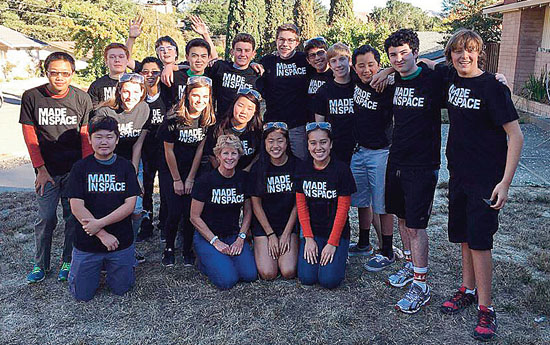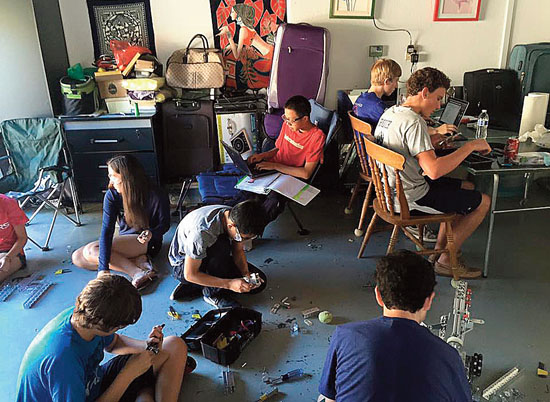 | | | The Campolindo Robotics Team sporting "Made In Space" T-shirts. Photos Zoe Portnoff | | | | | | Recently, millennials have taken up a new name for themselves within the scientific community: Generation Mars. With exciting new developments such as zero gravity 3D printers, scientists have reason to look hopefully toward the future of space exploration and technology. At Campolindo High School, students in the Robotics Club can be found directly contributing to these advancements. Campolindo students are acting as a pilot group for Space Games, a program launched by Made In Space. In this program, students have been designing a game to be 3D printed in the International Space Station.
 Mary Jo "MJ" Marggraff, the creator of Space Games, first approached Campolindo teachers about the program in 2014, and began working with the Robotics Club in September 2015. The Campolindo Makers Club was also involved in creating the earlier designs. "It was actually going to be a competition between multiple schools, but it ended up being just our school that would be creating a design for the first year," explained Bennett Coates, co-captain of the club. "We first made a lot of sketches, but now we are going to make a rough model and 3D-print it on Earth, and the final model is going to be printed on the ISS by the Made In Space printer."
Mary Jo "MJ" Marggraff, the creator of Space Games, first approached Campolindo teachers about the program in 2014, and began working with the Robotics Club in September 2015. The Campolindo Makers Club was also involved in creating the earlier designs. "It was actually going to be a competition between multiple schools, but it ended up being just our school that would be creating a design for the first year," explained Bennett Coates, co-captain of the club. "We first made a lot of sketches, but now we are going to make a rough model and 3D-print it on Earth, and the final model is going to be printed on the ISS by the Made In Space printer."
 Space Games proved to be a difficult but fun challenge for the Robotics Club. The design was limited to certain dimensions, and small loose parts were not allowed due to safety hazards. In addition to fulfilling these requirements, Campolindo students hoped to create a game that could only be played in space. "It's difficult trying to make a game for outer space when all you've ever known is a 1G environment for games. All of our earlier designs were things we've played on Earth with slight variations," Coates noted. Altenberg added, "Our program will hopefully inspire students to pursue engineering careers where they are able to learn and contribute to the production of things not necessarily just in space, but in 3D printing in general, which is a really revolutionary manufacturing technology."
Space Games proved to be a difficult but fun challenge for the Robotics Club. The design was limited to certain dimensions, and small loose parts were not allowed due to safety hazards. In addition to fulfilling these requirements, Campolindo students hoped to create a game that could only be played in space. "It's difficult trying to make a game for outer space when all you've ever known is a 1G environment for games. All of our earlier designs were things we've played on Earth with slight variations," Coates noted. Altenberg added, "Our program will hopefully inspire students to pursue engineering careers where they are able to learn and contribute to the production of things not necessarily just in space, but in 3D printing in general, which is a really revolutionary manufacturing technology."
 Made In Space, the company that launched Space Games, created the first 3D printer able to operate in zero gravity, which was sent up to the International Space Station on Sept. 21, 2014. The company hopes that this new technology will accelerate space development and enable the future of space exploration.
Made In Space, the company that launched Space Games, created the first 3D printer able to operate in zero gravity, which was sent up to the International Space Station on Sept. 21, 2014. The company hopes that this new technology will accelerate space development and enable the future of space exploration.
 "The ability to construct from one material almost infinitely many devices and objects is really incredible, especially in space, where we have a really limited number of resources. Having the ability to produce things without a huge manufacturing process is really important and impressive," Ray Altenberg, co-captain of the Robotics Club, explained. "While our project doesn't have a necessarily practical application, the brainstorming and the effort that goes into developing such a product is similar to the work that goes into creating more essential items. The concept behind this challenge is that we have to come up with something that would be interesting on, say, a trip to Mars, which would take two to four years. The idea that you could have someone on earth design these things for you, send a file to you, and then you could have the object even though you're millions of miles away in space is pretty fantastic."
"The ability to construct from one material almost infinitely many devices and objects is really incredible, especially in space, where we have a really limited number of resources. Having the ability to produce things without a huge manufacturing process is really important and impressive," Ray Altenberg, co-captain of the Robotics Club, explained. "While our project doesn't have a necessarily practical application, the brainstorming and the effort that goes into developing such a product is similar to the work that goes into creating more essential items. The concept behind this challenge is that we have to come up with something that would be interesting on, say, a trip to Mars, which would take two to four years. The idea that you could have someone on earth design these things for you, send a file to you, and then you could have the object even though you're millions of miles away in space is pretty fantastic."
 Campolindo's Robotics Team is also currently participating in First Tech Challenge, or FTC, a nationwide competition in which students in grades 7-12 design, build, program, and operate robots to work with or against other teams to complete a certain task. "Bad hardware made our season far more troublesome than expected, but we still finished with six awards and accomplished a lot," Altenberg said about the season.
Campolindo's Robotics Team is also currently participating in First Tech Challenge, or FTC, a nationwide competition in which students in grades 7-12 design, build, program, and operate robots to work with or against other teams to complete a certain task. "Bad hardware made our season far more troublesome than expected, but we still finished with six awards and accomplished a lot," Altenberg said about the season.
 Campolindo's Robotics Club was created in 2005, making this season its 10th year participating in First Tech Challenge. Recently, the Campolindo team won the Judges' Award at the Intel Folsom Qualifier, a FTC competition, for their efforts in Space Games.
Campolindo's Robotics Club was created in 2005, making this season its 10th year participating in First Tech Challenge. Recently, the Campolindo team won the Judges' Award at the Intel Folsom Qualifier, a FTC competition, for their efforts in Space Games.

|

